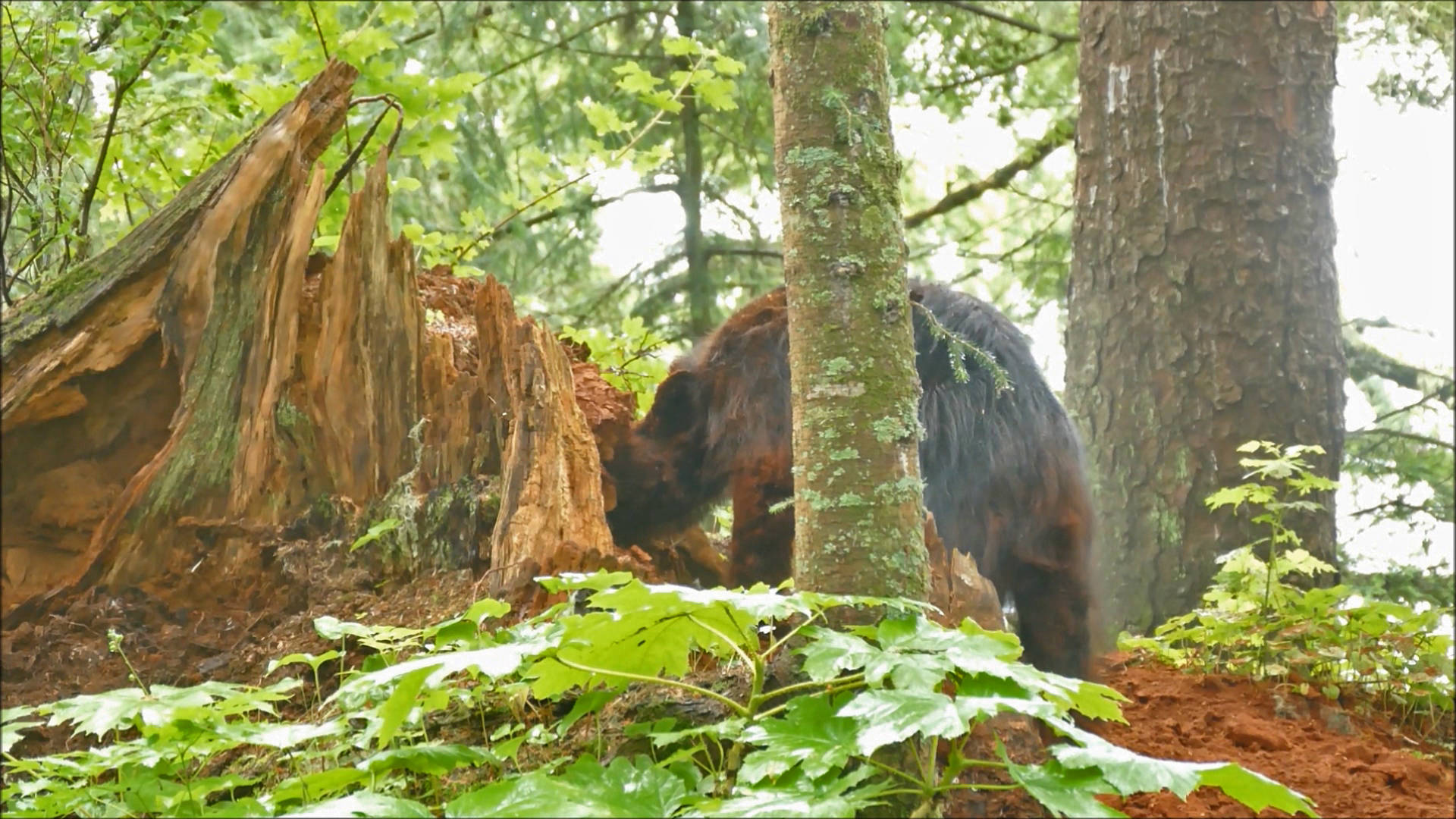In mid-July, a bear with a yellow ear tag came through my yard several times. Known as No. 103, she was primarily interested in eating horsetail (and peering in my windows). Lying comfortably on her side, she’d scoop an armful toward her mouth and chomp, move over a little bit and do it again. This bear is estimated to be about 24 years old, looking a bit scruffy and probably too old to have cubs anymore. Her last cub was born in 2019, but we know she had one in 2017 and triplets in 2014 and surely several other cubs before that.
I wonder if mid-July of this year might have been a difficult time for our bears. The fish weren’t in yet, and the berry crops were not fully ripe yet (it was a slow spring). So maybe then the bears snack on whatever they can find, including horsetail, ground cone and insects. Insects? For a big critter like a bear? Sure.
A well-known local naturalist and photographer caught a black bear in action, vigorously shredding a big, rotten stump and excavating the major roots, where ants had established a colony. Of course, the ants desperately tried to save their eggs and pupae, carrying them off in hopes of finding a safer place. I went out to look at that old stump and found the bear had dug a hole about three feet deep.
In fact, North American black and brown (grizzly) bears are known to eat insects regularly. Insect remains are common in bear scats, especially in summer: ants, wasps, bees, beetles and moths are reported to occur in bear scats, in some cases occurring in 96% of scats and comprising over 50% of scat volume. While it may be common for a bear to snarf up a wandering beetle here and there, a bear obviously gets the biggest returns by focusing on insects that cluster in groups.
Perhaps the best known bear-and-bug story is that of bears eating cutworm moths in the mountainous west. Cutworm moths migrate to alpine areas in summer, and there they forage on nectar before returning to lower elevations in the fall, to mate and lay eggs. The moths typically forage at dusk of night-time, and during the day they hide out under rocks in talus slopes, sometimes in huge clusters. Some of these rocky slopes are traditional cutworm hideouts, and bears travel to them and turn over the rocks for summer feasts. The disturbed moths sometimes run out and all over the marauding bear, who just licks them up while gobbling up the main group. Cutworm moths are good value—they are reported to be seventy percent protein before they lay on fat from nectaring all summer, and then they may be over seventy percent fat. A bear may consume over forty thousand moths a day. At about half a calorie per moth, that’s a lot of calories per bear. Grizzly bears are most noted for capitalizing on this bonanza, but black bears do it, too.
Sometimes ladybugs (ladybird beetles) aggregate in large numbers at upper elevations, to hibernate where they have a protective blanket of snow. Bears find these aggregations in late summer and collect mouthfuls of the little beetles.
In Minnesota, the broods of ants are a major food for black bears in summer. Although the bears may get only a few grams of larvae and pupae per colony, ant colonies are apparently quite common in that region. The bears hunt ant colonies chiefly by ripping open logs or flipping rocks. Ants try to defend a bear-raided colony with sprays of irritating formic acid, but the bears just tolerate that.
Also in Minnesota, black bears eat a lot of forest tent caterpillars in summer. Despite their name, these caterpillars don’t make tents as their relatives do. Instead, they make a silken mat where they gather to molt or just to rest between bouts of defoliating deciduous trees; the larvae travel to and from feeding sites on silken threads. Forest tent caterpillars undergo massive population outbreaks roughly every 10-16 years (why?) and each outbreak lasts for several years; then the bears have easy hunting. The caterpillars are covered in stiff hairs and contain crystals of calcium oxalate, which make them unpalatable to most animals. But the bears are not deterred: they are recorded to eat over twenty thousand caterpillars (or about twenty pounds) per day. These remarkable numbers are known because the caterpillar skins pass intact through the bears’ digestive tracts, and researchers recorded the numbers of skins in bear scats.
Bears love honey—Winnie the Pooh being most famous. But bears in the wild rip open trees housing bee nests to get not just honey but the honey comb filled with bee larvae. The stings of angry bees are ignored. Around here, I wonder if bears molest the relatively small nests of bumblebees, sometimes located in the ground or in old mouse nests or in a variety of other places.
Here in Southeast, there are not many opportunities for a bear to cash in on big groups of insects, much less for an observer to see a bear in action. A lucky observation!
Thanks to bear watchers at the visitor center for info on Bear 103 and Bob Armstrong for the video.
• Mary F. Willson is a retired professor of ecology. “On the Trails” appears every Wednesday in the Juneau Empire.

